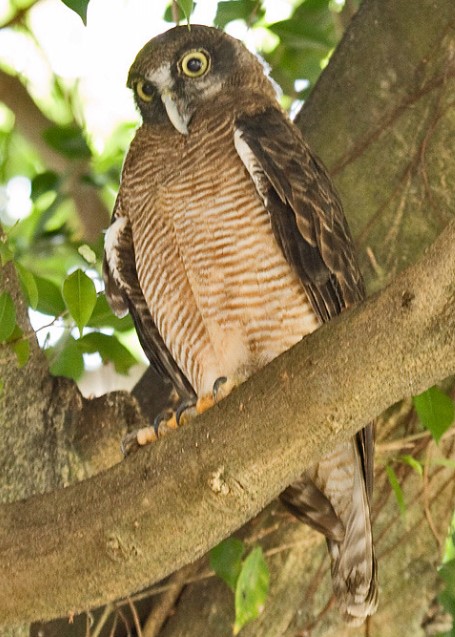Diet: Rarely seen Rufous Owls (Ninox rufa) feed mainly on birds and arboreal mammals, such as Sugar Gliders (Petaurus breviceps), and flying foxes, which it snatches from foliage and branches of trees with its talons. It also appears that these owls prey on other birds more often than ground-dwelling mammals during the wet season, when ground vegetation is dense. Also, the availability of prey during different seasons plays an important role in selecting prey. The rufous owl has been observed using a variety of predation methods to catch its prey.
In the daytime, it roosts in leafy trees that command a view of the surrounding area. It often carries the remains of a kill to the roost. In each pair, there seems to be more than one roost. Perches, snatching from foliage in flight, chasing in flight, or swooping from the air and catching their prey from the ground or water are all possible methods of catching their prey.
Family: It is a species of owl in the Strigidae family and is also called the rufous boobook. It is a silent owl, with quick flapping flight interspersed with long glides, and well suited for catching prey.
Behavior: There is a tendency for rufous owls to be shy and elusive, but they can become aggressive if threatened. It catches and consumes stick insects and beetles as well. In rainforests and similar dense forests, it seems to hold large, permanent territories and hunt at night in adjacent eucalypt forests and woodlands. While rufous owls tend to be secretive, they defend their nest vigorously during the breeding season by slipping away from their daytime roosts.
Name: An English ornithologist named John Gould described it in 1846. This owl gets its name from its rufous-colored feathers when it reaches adulthood.
Size: Approximately 470–550 mm long is the size of Rufous Owls.
Identification: There is no difference in size between the sexes, except that the male owl is slightly larger. In the upper parts, the color is a dark brown with fine pale cream bars; on the wings and tail, the bars are coarser. There are fine, rufous-brown bars on the underparts of the bird. Dark sides of the face; dusky mask around the eyes. The eyes are lemon-colored. Blueish white is the color of the bill and cere. The toes are yellow, and the claws are slate-black. An immature owl looks like an adult owl. The downy young, however, have flesh-white feet and are white-downed.
Sound: There is a mournful woo-hoo in Rufous Owl’s territorial call, similar to Powerful Owl’s, though it is softer and falls in pitch. The call is given primarily during the opening nesting season. There is a higher pitch to the voice of the female than that of the male. There is humming, twittering, and chirruping between the sexes during courtship. Nestlings utilize a coarse-tipped whistle to cry out for help.

Breeding and Nesting: Breeding and nesting take place between June and September, with one brood per year. A nest made by an owl is a vertical or steeply sloping, deep hollow in the trunk of an eucalyptus or paperbark tree. Young owls are dependent on their parents for many months after hatching, often until the following breeding season. Nests are usually found between 10 and 40 meters high. Both sexes clean out and prepare the nest access, which is gained from the side and lined with wood debris and dead leaves. Both males and females will aggressively defend their nests against predators and intruders while their young are inside. Furthermore, the same nest is used repeatedly. The species is rarely aggressive toward humans, except in situations where it feels threatened by humans or its offspring.
Eggs: The owl lays two (or one) eggs every two to three nights. Approximately 50–55 mm in diameter and of creamy white color. It takes the female about 36–38 days to incubate. The male feeds the female outside the nest. It takes six to eight weeks for the young to fledge.
Distribution-wise, there are three races: one in coastal northeastern Queensland north of Cooktown (dark and small); another in coastal Cape York Peninsula (pale and small); and a third in coastal Arnhem Land and the Kimberleys (large and pale). New Guinea is also home to the owl. During the dry season, hunters, forest clearers, and forest fires threaten the rufous owl, as they do many other birds.
Read More: Grass Owl







